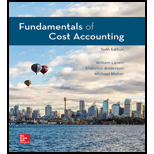
Fundamentals of Cost Accounting
6th Edition
ISBN: 9781260708783
Author: LANEN, William
Publisher: MCGRAW-HILL HIGHER EDUCATION
expand_more
expand_more
format_list_bulleted
Concept explainers
Textbook Question
Chapter 3, Problem 35E
Analysis of Cost Structure
Spring Company’s cost structure is dominated by variable costs with a contribution margin ratio of .20 and fixed costs of $60,000. Every dollar of sales contributes 20 cents toward fixed costs and profit. The cost structure of a competitor, Winters Company, is dominated by fixed costs with a higher contribution margin ratio of .70 and fixed costs of $310,000. Every dollar of sales contributes 70 cents toward fixed costs and profit. Both companies have sales of $500,000 per month.
Required
- a. Compare the two companies’ cost structures using the format shown in Exhibit 3.5.
- b. Suppose that both companies experience an 8 percent increase in sales volume. By how much would each company’s profits increase?
Expert Solution & Answer
Trending nowThis is a popular solution!

Students have asked these similar questions
Given correct answer general accounting question
Calculate summit's net income for the year on these financial accounting question
In its 2015 annual report
Chapter 3 Solutions
Fundamentals of Cost Accounting
Ch. 3 - Write out the profit equation and describe each...Ch. 3 - What are the components of total costs in the...Ch. 3 - How does the total contribution margin differ from...Ch. 3 - Compare cost-volume-profit (CVP) analysis with...Ch. 3 - Fixed costs are often defined as fixed over the...Ch. 3 - Prob. 6RQCh. 3 - What is the margin of safety? Why is this...Ch. 3 - Prob. 8RQCh. 3 - Write out the equation for the target volume (in...Ch. 3 - How do income taxes affect the break-even...
Ch. 3 - Why is it common to assume a fixed sales mix...Ch. 3 - What are some important assumptions commonly made...Ch. 3 - Prob. 13CADQCh. 3 - Prob. 14CADQCh. 3 - The typical cost-volume-profit graph assumes that...Ch. 3 - The assumptions of CVP analysis are so simplistic...Ch. 3 - Prob. 17CADQCh. 3 - Consider a class in a business school where volume...Ch. 3 - Prob. 19CADQCh. 3 - Prob. 20CADQCh. 3 - Consider the Business Application,...Ch. 3 - Consider the Business Application,...Ch. 3 - Prob. 23CADQCh. 3 - Profit Equation Components Identify each of the...Ch. 3 - Profit Equation Components Identify the letter of...Ch. 3 - Basic Decision Analysis Using CVP Anus Amusement...Ch. 3 - Basic CVP Analysis The manager of Dukeys Shoe...Ch. 3 - CVP AnalysisEthical Issues Mark Ting desperately...Ch. 3 - Basic Decision Analysis Using CVP Derby Phones is...Ch. 3 - Prob. 30ECh. 3 - Basic Decision Analysis Using CVP Warner Clothing...Ch. 3 - Basic Decision Analysis Using CVP Refer to the...Ch. 3 - Prob. 33ECh. 3 - Prob. 34ECh. 3 - Analysis of Cost Structure Spring Companys cost...Ch. 3 - CVP and Margin of Safety Bristol Car Service...Ch. 3 - CVP and Margin of Safety Caseys Cases sells cell...Ch. 3 - Prob. 38ECh. 3 - Prob. 39ECh. 3 - Refer to the data for Derby Phones in Exercise...Ch. 3 - Refer to the data for Warner Clothing in Exercise...Ch. 3 - CVP with Income Taxes Hunter Sons sells a single...Ch. 3 - CVP with Income Taxes Hammerhead Charters runs...Ch. 3 - Prob. 44ECh. 3 - Prob. 45ECh. 3 - Prob. 46ECh. 3 - Prob. 47ECh. 3 - CVP Analysis and Price Changes Argentina Partners...Ch. 3 - Prob. 49PCh. 3 - CVP AnalysisMissing Data Breed Products has...Ch. 3 - Prob. 51PCh. 3 - Prob. 52PCh. 3 - CVP AnalysisSensitivity Analysis (spreadsheet...Ch. 3 - Prob. 54PCh. 3 - Prob. 55PCh. 3 - Extensions of the CVP ModelSemifixed (Step) Costs...Ch. 3 - Prob. 57PCh. 3 - Extensions of the CVP ModelTaxes Odd Wallow Drinks...Ch. 3 - Prob. 59PCh. 3 - Prob. 60PCh. 3 - Extensions of the CVP ModelTaxes Toys 4 Us sells...Ch. 3 - Extensions of the CVP AnalysisTaxes Eagle Company...Ch. 3 - Extensions of the CVP ModelMultiple Products...Ch. 3 - Extensions of the CVP ModelMultiple Products...Ch. 3 - Prob. 65PCh. 3 - Prob. 66PCh. 3 - Prob. 67PCh. 3 - Prob. 68PCh. 3 - Extensions of the CVP ModelMultiple Products and...Ch. 3 - Extensions of the CVP ModelTaxes With Graduated...Ch. 3 - Prob. 71PCh. 3 - Financial Modeling Three entrepreneurs were...
Knowledge Booster
Learn more about
Need a deep-dive on the concept behind this application? Look no further. Learn more about this topic, accounting and related others by exploring similar questions and additional content below.Similar questions
- On average, FurniStyle Ltd. is able to sell its inventory in 30 days. The firm takes 90 days on average to pay for its purchases. On the other hand, its average customer pays with a credit card, which allows the firm to collect its receivables in 6 days. What is the length of the operating cycle?arrow_forwardA stock sells for $20 per share. What is the book value of the company if the price-to-book value ratio is 1.6 and it has 120,000 shares of stock outstanding? Solve thisarrow_forwardWhat is the price earnings ratioarrow_forward
arrow_back_ios
SEE MORE QUESTIONS
arrow_forward_ios
Recommended textbooks for you
 Managerial Accounting: The Cornerstone of Busines...AccountingISBN:9781337115773Author:Maryanne M. Mowen, Don R. Hansen, Dan L. HeitgerPublisher:Cengage Learning
Managerial Accounting: The Cornerstone of Busines...AccountingISBN:9781337115773Author:Maryanne M. Mowen, Don R. Hansen, Dan L. HeitgerPublisher:Cengage Learning

Managerial Accounting: The Cornerstone of Busines...
Accounting
ISBN:9781337115773
Author:Maryanne M. Mowen, Don R. Hansen, Dan L. Heitger
Publisher:Cengage Learning
Cost-Volume-Profit (CVP) Analysis and Break-Even Analysis Step-by-Step, by Mike Werner; Author: Accounting Step by Step;https://www.youtube.com/watch?v=D0MOfse9OWk;License: Standard Youtube License